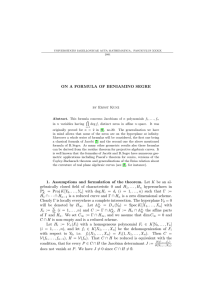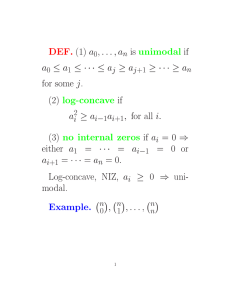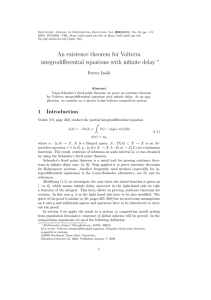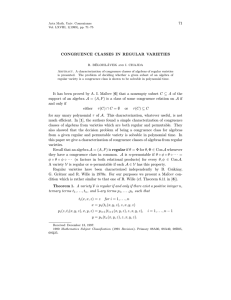Georg Alexander Pick (1859–1942) : lattice polygon in R (vertices ∈ Z
advertisement
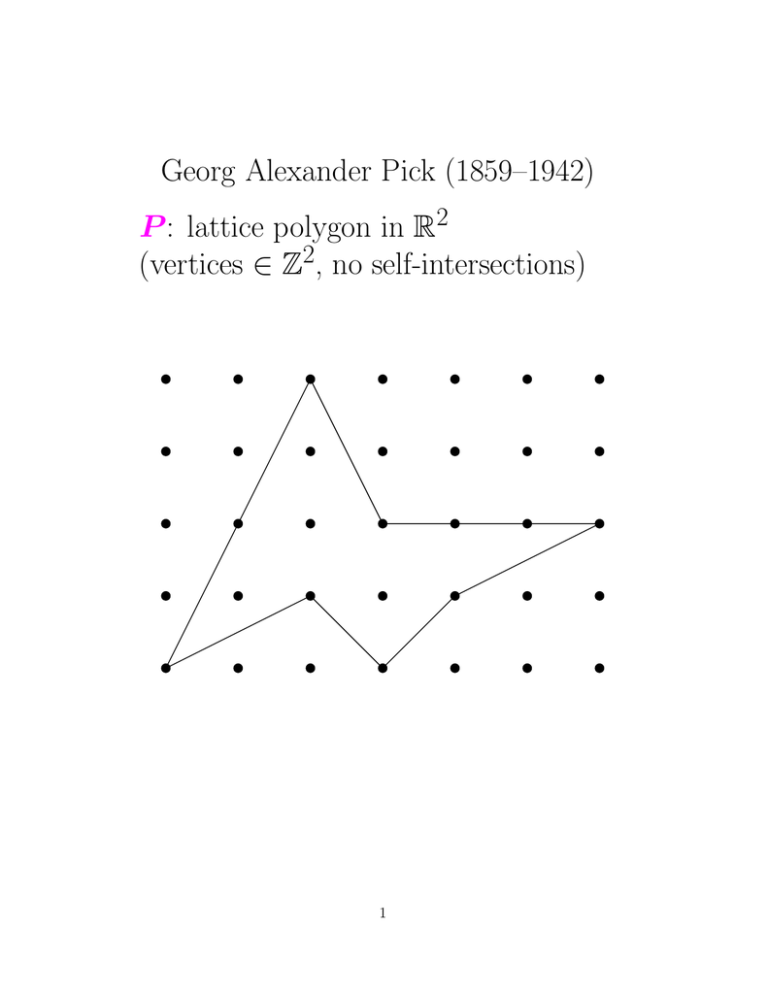
Georg Alexander Pick (1859–1942)
P : lattice polygon in R2
(vertices ∈ Z2, no self-intersections)
1
A = area of P
I = # interior points of P (= 4)
B = #boundary points of P (= 10)
Then
2I + B − 2 2 · 4 + 10 − 2
A=
=
= 9.
2
2
2
Pick’s theorem (seemingly) fails in higher
dimensions. For example, let T1 and T2
be the tetrahedra with vertices
v(T1) = {(0, 0, 0), (1, 0, 0), (0, 1, 0), (0, 0, 1)}
v(T2) = {(0, 0, 0), (1, 1, 0), (1, 0, 1), (0, 1, 1)}.
Then
I(T1) = I(T2) = 0
B(T1) = B(T2) = 4
A(T1) = 1/6, A(T2) = 1/3.
3
Let P be a convex polytope (convex
hull of a finite set of points) in Rd. For
n ≥ 1, let
nP = {nα : α ∈ P}.
P
3P
4
Let
i(P, n) = #(nP ∩ Zd)
= #{α ∈ P : nα ∈ Zd},
the number of lattice points in nP.
Similarly let
P ◦ = interior of P = P − ∂P
ī(P, n) = #(nP ◦ ∩ Zd)
= #{α ∈ P ◦ : nα ∈ Zd},
5
P
3P
i(P, n) = (n + 1)2
ī(P, n) = (n − 1)2 = i(P, −n).
6
lattice polytope: polytope with integer vertices
Theorem (Reeve, 1957). Let P be
a three-dimensional lattice polytope.
Then the volume V (P) is a certain
(explicit) function of i(P, 1), ī(P, 1),
and i(P, 2).
7
Theorem (Ehrhart 1962, Macdonald 1963) Let
P = lattice polytope in RN , dim P = d.
Then i(P, n) is a polynomial (the Ehrhart polynomial of P) in n of degree d. Moreover,
i(P, 0) = 1
ī(P, n) = (−1)di(P, −n), n > 0
(reciprocity).
If d = N then
i(P, n) = V (P)nd + lower order terms,
where V (P) is the volume of P.
8
Corollary (generalized Pick’s theorem). Let P ⊂ Rd and dim P = d.
Knowing any d of i(P, n) or ī(P, n)
for n > 0 determines V (P).
Proof. Together with i(P, 0) = 1,
this data determines d + 1 values of the
polynomial i(P, n) of degree d. This
uniquely determines i(P, n) and hence
its leading coefficient V (P). 2
Example. When d = 3, V (P) is
determined by
i(P, 1) = #(P ∩ Z3)
i(P, 2) = #(2P ∩ Z3)
ī(P, 1) = #(P ◦ ∩ Z3),
which gives Reeve’s theorem.
9
Example (magic squares). Let BM ⊂
RM ×M be the Birkhoff polytope of
all M ×M doubly-stochastic matrices A = (aij ), i.e.,
aij ≥ 0
X
aij = 1 (column sums 1)
X
aij = 1 (row sums 1).
i
j
10
Note. B = (bij ) ∈ nBM ∩ ZM ×M
if and only if
bij ∈ N = {0, 1, 2, . . .}
X
bij = n
X
bij = n.
i
j
2
3
1
1
1
1
3
2
0
1
2
4
4
2
1
0
(M = 4, n = 7)
11
HM (n) := #{M × M N-matrices, line sums n}
= i(BM , n).
E.g.,
H1(n) = 1
H2(n) = n + 1
a n−a
,
n−a a
H3(n) =
0 ≤ a ≤ n.
n+2
n+3
n+4
+
+
4
4
4
(MacMahon)
12
HM (0) = 1
HM (1) = M ! (permutation matrices)
Theorem (Birkhoff-von Neumann) The
vertices of BM consist of the M ! M ×
M permutation matrices. Hence BM
is a lattice polytope.
Corollary (Anand-Dumir-Gupta conjecture) HM (n) is a polynomial in n
(of degree (M − 1)2).
1 Example. H4(n) =
11n9
11340
+198n8 + 1596n7 + 7560n6 + 23289n5
+48762n5 + 70234n4 + 68220n2
+40950n + 11340) .
13
Reciprocity ⇒
±HM (−n) = #{M ×M matrices B of
positive integers, line sum n}.
But every such B can be obtained from
an M × M matrix A of nonnegative
integers by adding 1 to each entry.
Corollary. HM (−1) = HM (−2) =
· · · = HM (−M + 1) = 0
HM (−M − n) = (−1)M −1HM (n)
(greatly reduces computation)
Applications e.g. to statistics (contingency tables).
14
Zeros of H_9(n)
3
2
1
–8
–6
–4
–2
0
–1
–2
–3
15
Zonotopes. Let v1, . . . , vk ∈ Rd.
The zonotope Z(v1, . . . , vk ) generated
by v1, . . . , vk :
Z(v1, . . . , vk ) = {λ1v1+· · ·+λk vk : 0 ≤ λi ≤ 1}
Example. v1 = (4, 0), v2 = (3, 1),
v3 = (1, 2)
(1,2)
(3,1)
(0,0)
(4,0)
16
Theorem. Let
Z = Z(v1, . . . , vk ) ⊂ Rd,
where vi ∈ Zd. Then
X
i(Z, 1) =
h(X),
X
where X ranges over all linearly independent subsets of {v1, . . . , vk }, and
h(X) is the gcd of all j × j minors
(j = #X) of the matrix whose rows
are the elements of X.
17
Example. v1 = (4, 0), v2 = (3, 1),
v3 = (1, 2)
(1,2)
(3,1)
(0,0)
(4,0)
4 0 4 0 3 1
+
+
i(Z, 1) = 1 2
1 2
31
+gcd(4, 0) + gcd(3, 1)
+gcd(1, 2) + det(∅)
= 4+8+5+4+1+1+1
= 24.
18
Let G be a graph (with no loops or
multiple edges) on the vertex set V (G) =
{1, 2, . . . , n}. Let
di = degree (# incident edges) of vertex i.
Define the ordered degree sequence
d(G) of G by
d(G) = (d1, . . . , dn).
Example. d(G) = (2, 4, 0, 3, 2, 1)
1
2
3
4
5
6
19
Let f (n) be the number of distinct
d(G), where V (G) = {1, 2, . . . , n}.
Example. If n ≤ 3, all d(G) are
distinct, so f (1) = 1, f (2) = 21 = 2,
f (3) = 23 = 8. For n ≥ 4 we can have
G 6= H but d(G) = d(H), e.g.,
1
2
1
2
1
2
3
4
3
4
3
4
In fact, f (4) = 54 < 26 = 64.
20
Let conv denote convex hull, and
Dn = conv{d(G) : V (G) = {1, . . . , n}},
the polytope of degree sequences
(Perles, Koren).
Easy fact. Let ei be the ith unit
coordinate vector in Rn. E.g., if n = 5
then e2 = (0, 1, 0, 0, 0). Then
Dn = Z(ei + ej : 1 ≤ i < j ≤ n).
Theorem (Erdős-Gallai). Let α =
(a1, . . . , an) ∈ Zn. Then α = d(G)
for some G if and only if
• α ∈ Dn
• a1 + a2 + · · · + an is even.
21
“Fiddling around” leads to:
Theorem. Let
X
xn
F (x) =
f (n)
n!
n≥0
x2
x3
x4
= 1 + x + 2 + 8 + 54 + · · · .
2!
3!
4!
Then
1/2
n
X
1
x
F (x) = 1 + 2
nn
2
n!
n≥1
× 1 −
X
n
x
(n − 1)n−1 + 1
n!
n≥1
× exp
X
n≥1
22
n
x
nn−2 .
n!
The h-vector of i(P, n)
Let P denote the tetrahedron with
vertices (0, 0, 0), (1, 0, 0), (0, 1, 0), (1, 1, 13).
Then
1
13 3
2
i(P, n) = n + n − n + 1.
6
6
Thus in general the coefficients of Ehrhart
polynomials are not “nice.” Is there a
“better” basis?
23
y
x
z
24
Let P be a lattice polytope of dimension d. Since i(P, n) is a polynomial of
degree d, ∃ hi ∈ Z such that
d
X
h
+
h
x
+
·
·
·
+
h
x
1
d
.
i(P, n)xn = 0
d+1
(1 − x)
n≥0
Definition. Define
h(P) = (h0, h1, . . . , hd),
the h-vector of P.
25
Example. Recall
1
i(B4, n) =
(11n9
11340
+198n8 + 1596n7 + 7560n6 + 23289n5
+48762n5 + 70234n4 + 68220n2
+40950n + 11340).
Then
h(B4) = (1, 14, 87, 148, 87, 14, 1, 0, 0, 0).
26
Elementary properties of
h(P) = (h0, . . . , hd):
• h0 = 1
• hd = (−1)dim P i(P, −1) = I(P)
• max{i : hi 6= 0} = min{j ≥ 0 :
i(P, −1) = i(P, −2) = · · ·
= i(P, −(d − j)) = 0}
E.g., h(P) = (h0, . . . , hd−2, 0, 0) ⇔
i(P, −1) = i(P, −2) = 0.
• i(P, −n − k) = (−1)d i(P, n) ∀n ⇔
hi = hd+1−k−i ∀i, and
hd+2−k−i = hd+3−k−i = · · · = hd = 0
27
Recall:
h(B4) = (1, 14, 87, 148, 87, 14, 1, 0, 0, 0).
Thus
i(B4, −1) = i(B4, −2) = i(B4, −3) = 0
i(B4, −n − 4) = −i(B4, n).
28
Theorem A (nonnegativity). (McMullen, RS) hi ≥ 0.
Theorem B (monotonicity). (RS)
If P and Q are lattice polytopes and
Q ⊆ P, then hi(Q) ≤ hi(P) ∀i.
B ⇒ A: take Q = ∅.
Theorem A can be proved geometrically, but Theorem B requires commutative algebra.
29
P = lattice polytope in Rd
R = RP = vector space over K with basis
{xαy n : α ∈ Zd, n ∈ P, α/n ∈ P}∪{1},
where if α = (α1, . . . , αd) then
αd
α1
α
x = x1 · · · x d .
If α/m, β/n ∈ P, then
(α + β)/(m + n) ∈ P
by convexity. Hence RP is a subalgebra of the polynomial ring K[x1, . . . , xd, y].
30
Example. (a) Let
P = conv{(0, 0), (0, 1), (1, 0), (1, 1)}.
Then
RP = K[y, x1 y, x2 y, x1x2 y].
(b) Let
P = conv{(0, 0, 0), (1, 1, 0), (1, 0, 1), (0, 1, 1)}.
Then
RP = K[y, x1x2 y, x1x3 y, x2x3 y, x1x2x3 y 2].
31
Let
Rn = spanK {xαy n : α/n ∈ P},
with R0 = spanK {1} = K. Then
R = R0 ⊕ R1 ⊕ · · · (vector space ⊕)
RiRj ⊆ Ri+j .
Thus R is a graded algebra. Moreover,
dimK Rn = #{xαy n : α/n ∈ P}
= i(P, n).
Thus i(P, n) is the Hilbert function
of R. Moreover,
X
F (P, x) :=
i(P, n)xn
n≥0
is the Hilbert series of RP .
32
Theorem (Hochster). Let P be a
lattice polytope of dimension d. Then
RP is a Cohen-Macaulay ring.
This means: ∃ algebraically independent θ1, . . . , θd+1 ∈ R1 (called a homogeneous system of parameters
or h.s.o.p.) such that RP is a finitely
generated free module over
S = K[θ1, . . . , θd+1].
Thus ∃ η1, . . . , ηs (ηi ∈ Rei ) such that
s
M
ηi S
RP =
i=1
and ηiS ∼
= S (as S-modules).
33
Now
X
F (RP , x) :=
n≥0
s
X
=
i(P, n)xn
xei F (S, x)
i=1
Ps
ei
x
i=1
=
.
d+1
(1 − x)
Compare with
h0 + h 1 x + · · · + h d xd
F (RP , x) =
(1 − x)d+1
to conclude:
Corollary.
s
X
xei =
i=1
particular, hi ≥ 0.
34
d
X
j=0
hj xj . In
Now suppose:
P, Q : lattice polytopes in RN
dim P = d, dim Q = e
Q ⊆ P.
Let
I = spanK {xαy n : α ∈ ZN , α/n ∈ P−Q}.
Easy: I is an ideal of RP and
R /I ∼
=R .
Q
P
35
Lemma. ∃ an h.s.o.p. θ1, . . . , θd+1
for RP such that θ1, . . . , θe+1 is an
h.s.o.p. for RQ and
θe+2, . . . , θd+1 ∈ I.
Thus
RQ/(θ1, . . . , θe+1) ∼
= RQ/(θ1, . . . , θd+1),
so the natural surjection f : RP → RQ
induces a (degree-preserving) surjection
f¯ : AP := RP /(θ1, . . . , θd+1)
→ AQ := RQ/(θ1, . . . , θe+1).
Since RP and RQ are Cohen-Macaulay,
dim(AP )i = hi(P), dim(AQ)i = hi(Q).
The surjection
(AP )i → (AQ)i
gives hi(P) ≥ hi(Q). 2
36
Zeros of Ehrhart polynomials.
Sample theorem (de Loera, Develin, Pfeifle, RS) Let P be a lattice
d-polytope. Then
i(P, α) = 0, α ∈ R ⇒ −d ≤ α ≤ bd/2c.
Theorem. Let d be odd. There exists a 0/1 d-polytope Pd and a real
zero αd of i(Pd, n) such that
1
αd
=
= 0.0585 · · · .
lim
d→∞ d
2πe
d odd
Open. Is the set of all complex zeros of all Ehrhart polynomials of lattice
polytopes dense in C? (True for chromatic polynomials of graphs.)
37
Further directions
• RP is the coordinate ring of a projective algebraic variety XP , a toric
variety. Leads to deep connections
with toric geometry, including new
formulas for i(P, n).
• Complexity. Computing i(P, n),
or even i(P, 1) is #P -complete.
Thus an “efficient” (polynomial time)
algorithm is extremely unlikely. However:
Theorem (A. Barvinok, 1994). For
fixed dim P, ∃ polynomial-time algorithm for computing i(P, n).
38
Reference. M. Barvinok and J. Pommersheim, An algorithmic theory of lattice points in polyhedra, in New Perspectives in Algebraic Combinatorics,
MSRI Publications, vol. 38, 1999, pp. 91–
147.
39



![5.5 The Haar basis is Unconditional in L [0, 1], 1 < 1](http://s2.studylib.net/store/data/010396305_1-450d5558097f626a0645448301e2bb4e-300x300.png)

